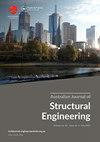frp -钢筋混凝土柱受压受力的数值与解析模拟
IF 1.3
Q4 ENGINEERING, CIVIL
Australian Journal of Structural Engineering
Pub Date : 2021-04-03
DOI:10.1080/13287982.2021.1923158
引用次数: 4
摘要
纤维增强聚合物(FRP)钢筋已经被研究人员和建筑行业的从业者公认为是在腐蚀性环境中传统钢材的有效替代品。然而,由于有限的研究和缺乏标准的设计指南,FRP筋作为纵向加固柱的应用尚未获得足够的信心。以往对FRP-RC柱偏心荷载作用的研究较少。本研究的重点是开发FRP-RC柱在轴向压缩载荷下的有限元模型(FEM)。FEM是根据文献中现有研究的测试结果进行校准的。采用截面分析方法建立了面向设计的FRP-RC柱轴向荷载和弯矩承载力计算模型。有限元和分析模型预测的荷载-位移特性和峰值荷载与试验结果吻合较好。最后,对混凝土等级、frp配筋比和柱长细比的影响进行了参数分析。在参数化研究的基础上,建议将单曲率弯曲、GFRP筋加固和CFRP筋加固的混凝土柱的长细比极限分别降低为14.2和21.2。本文章由计算机程序翻译,如有差异,请以英文原文为准。
Numerical and Analytical Modeling of FRP-Reinforced Concrete Columns Subjected to Compression Loading
ABSTRACT Fibre-reinforced polymer (FRP) bars have been acknowledged by the researchers as well as practitioners in the construction industry as effective alternatives to conventional steel in a corrosive environment. However, the application of FRP bars as longitudinal reinforcement in columns has not yet gained an adequate level of confidence due to limited research studies and lack of standard design guidelines. In the past, only a few studies have focused on FRP-reinforced concrete (FRP-RC) columns under eccentric loadings. This study focused on development of a finite element model (FEM) for FRP-RC columns subjected to axial compression loadings. FEM was calibrated against the test results of studies available in the literature. A design-oriented analytical model was developed using sectional analysis to calculate the axial load and bending moment capacity of FRP-RC columns. FEM and analytical model predicted load–displacement behaviour and peak load with close agreement to the test results. Finally, a parametric analysis was accomplished to explore the effect of concrete grade, FRP-reinforcement ratio, and slenderness ratio of columns. Based on the parametric study, it is recommended to reduce the limit of slenderness ratio to 14.2 and 21.2 for concrete columns, bent in single curvature, reinforced with GFRP and CFRP bars, respectively.
求助全文
通过发布文献求助,成功后即可免费获取论文全文。
去求助
来源期刊

Australian Journal of Structural Engineering
ENGINEERING, CIVIL-
CiteScore
2.50
自引率
0.00%
发文量
31
期刊介绍:
The Australian Journal of Structural Engineering (AJSE) is published under the auspices of the Structural College Board of Engineers Australia. It fulfils part of the Board''s mission for Continuing Professional Development. The journal also offers a means for exchange and interaction of scientific and professional issues and technical developments. The journal is open to members and non-members of Engineers Australia. Original papers on research and development (Technical Papers) and professional matters and achievements (Professional Papers) in all areas relevant to the science, art and practice of structural engineering are considered for possible publication. All papers and technical notes are peer-reviewed. The fundamental criterion for acceptance for publication is the intellectual and professional value of the contribution. Occasionally, papers previously published in essentially the same form elsewhere may be considered for publication. In this case acknowledgement to prior publication must be included in a footnote on page one of the manuscript. These papers are peer-reviewed as new submissions. The length of acceptable contributions typically should not exceed 4,000 to 5,000 word equivalents. Longer manuscripts may be considered at the discretion of the Editor. Technical Notes typically should not exceed about 1,000 word equivalents. Discussions on a Paper or Note published in the AJSE are welcomed. Discussions must address significant matters related to the content of a Paper or Technical Note and may include supplementary and critical comments and questions regarding content.
 求助内容:
求助内容: 应助结果提醒方式:
应助结果提醒方式:


